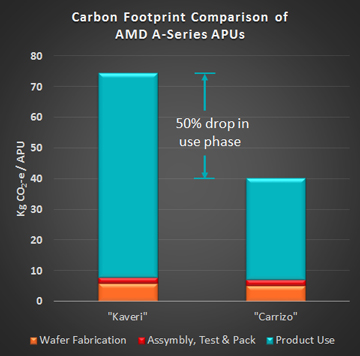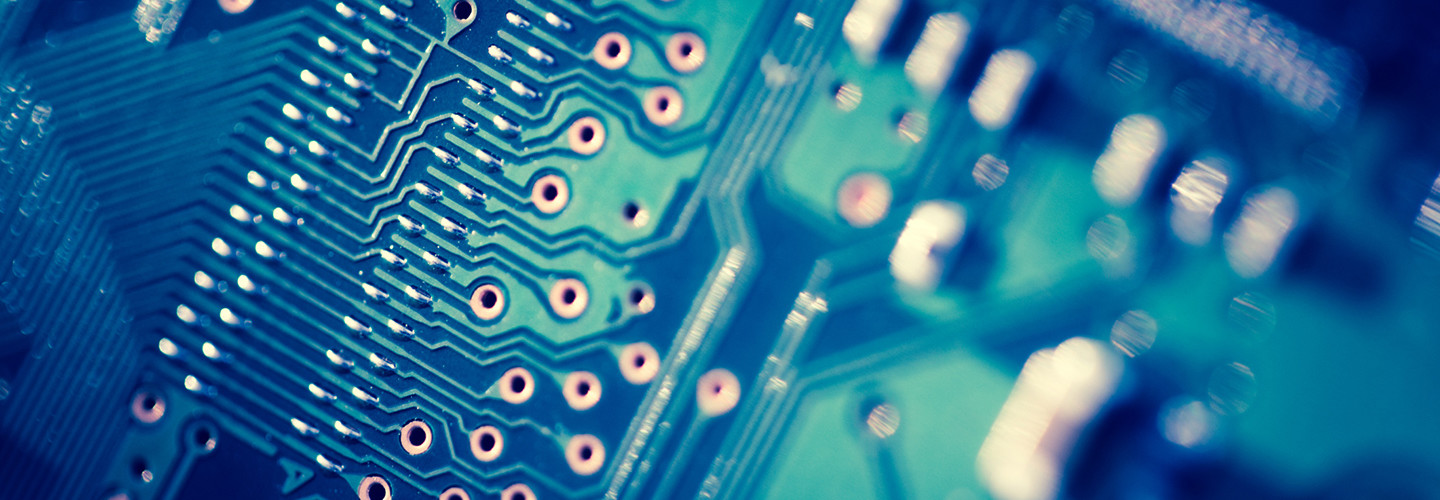Computer Chip Technology’s Shift Beyond Moore’s Law
With a shared marketing emphasis on power and speed, it’s easy to draw parallels between the automotive and computing industries.
Both would love to sell you their biggest and baddest, their fastest and most agile products – that’s where the money is. But anyone driving down an expressway these days can’t help but notice that a new category of cars — those marketed for a small environmental footprint such as the Toyota Prius, Nissan Leaf and Chevrolet Volt — is now sharing the roads.
The computer chip industry is noting the fading of Moore’s Law, with its assumed doubling of processing power every two years, so is now the time to focus on energy efficiency in computer chips? If so, AMD is poised to jump on this trend, thanks to its 25x20 initiative. In 2014, AMD announced an energy-efficiency goal of 25 times greater efficiency for its accelerated processing units (APUs) by 2020. This high-reaching efficiency goal can be read, in some ways, as AMD’s attempt to navigate a changing market.
“I think AMD’s approach is a fair response to the state of chip manufacturing today,” says Daniel Bizo, senior analyst of datacenter technologies for 451 Research. “It is getting difficult to continue increasing efficiencies, but that doesn’t mean that you stop. AMD’s commitment is aggressive. What they hope to accomplish is unique in that it goes far beyond what has been historically possible – nearly tripling, rather than doubling, efficiency every two years through 2020. Saying it is not going to be easy is an understatement.”
No More Moore?
Moore’s Law is no longer the benchmark for chip development that it has been for previous decades. The law began to yield in 2000, when peak output efficiency (one of the most common measures of computer efficiency) started slowing down.
Power efficiency improvements were no longer matching the processing power gains outlined by Moore. This meant that semiconductor manufacturers could no longer rely on manufacturing improvements alone to achieve efficiency improvements.
“The slowdown in generational chip efficiencies means that there’s increasing pressure on designers and programmers to offset this slowdown, to be smarter in designing and writing the code for the chips,” explains Bizo. “Energy efficiency is a core aspect of chip development. The IT industry has grown because of the success of chip manufacturers in driving these efficiencies. To maintain the pace of improvements, engineers now have to analyze the behavior of popular applications to find room for further efficiency gains.”
Sam Naffziger, an AMD corporate fellow, agrees. “We’re working in a new optimization space,” he says. “When you’re focusing on efficiency rather than pure performance, pushing it as hard as fast as you can, there’s a whole new set of capabilities that come into play for improvements. We are continuing to find new ways to drive efficiency without degrading performance.”
New Chip on the Block
Toward that goal, the chip manufacturer unveiled in June its first chip since the 25x20 goal announcement: the 6th generation A-series processor, previously code-named “Carrizo,” for notebook computers. Carrizo has shown to be about two times as efficient as its predecessor “Kaveri,” according to AMD, putting it ahead of the curve on the way to AMD’s 25x20 goal. AMD installed a number of efficiency-focused improvements into this chip.
“We’ve improved managing the power of the [central processing unit] CPU core,” explains Naffziger. “We’ve made it more efficient, but we’re actually making it smarter about when it actually fires up. It’s power gated. They only run as fast as necessary.”
Another efficiency improvement in Carrizo is the heterogeneous unified memory access (hUMA) technology that allows the CPU and graphics processor unit (GPU) to use the same memory space, improving performance and reducing the overall power demands on the chip. The new chip also optimizes the voltage in a way that results in an additional 10 to 19 percent cut in power use.
Chip Manufacturers Focus on Sustainability
Like automotive companies, AMD hopes to change the market conversation with its new focus on energy efficiency. It’s picked an opportune time. Increasingly, consumers are factoring in a company’s environmental impact and sustainability efforts in their purchase decisions.
“Sustainability goals are increasingly showing up in RFPs,” says Tim Mohin, director of corporate responsibility at AMD. “Organizations are demanding support from partners, especially in public sector contracts. They’re looking for energy efficiency and other product attributes, product content and materials, social and labor conditions in the product supply chain. So we’re definitely seeing a trend where we have to answer these kinds of sustainability questions in RFP situations.”
Power efficiency is proving to be a key aspect of IT sustainability – and with good reason. Our society operates under an economical and technological ecosystem that relies on continuing improvements in processing power, but at the cost of higher power consumption going forward.
Currently, there are over 5.16 billion individual Internet users worldwide. Cisco has projected a total of 50 billion Internet-connected devices by 2020. The number of smartphone users is expected to hit 2 billion in 2016. Collectively, that’s a lot of devices using a lot of microchips to process a lot of data – all of which requires power and contributes to the global carbon footprint. AMD is one of many IT manufacturers (including Intel, IBM and Nvidia) starting to work to reduce this growing footprint.
“We think of our energy-efficient design as a market differentiator for us,” offers Mohin. “And that lines up well with the biggest opportunities in terms of reducing the overall carbon footprint. Our biggest opportunity, and our biggest focus, is that use stage, where more than 80 percent of the carbon footprint impact occurs.”

Users can be thankful for all the computing gains that Moore’s Law has helped usher in, but now the computer chip industry says it’s time to start refining all those gains with sustainability in mind – and maybe have a little fun along the way.
“Moore’s Law has carried us far, and we’ll continue to squeeze out improvements in that way,” says Naffziger. “But the design capabilities, the architecture, the power management algorithms – all those things are going to be taking on a bigger role than they used to. And that’s fun for us, as engineers.”








